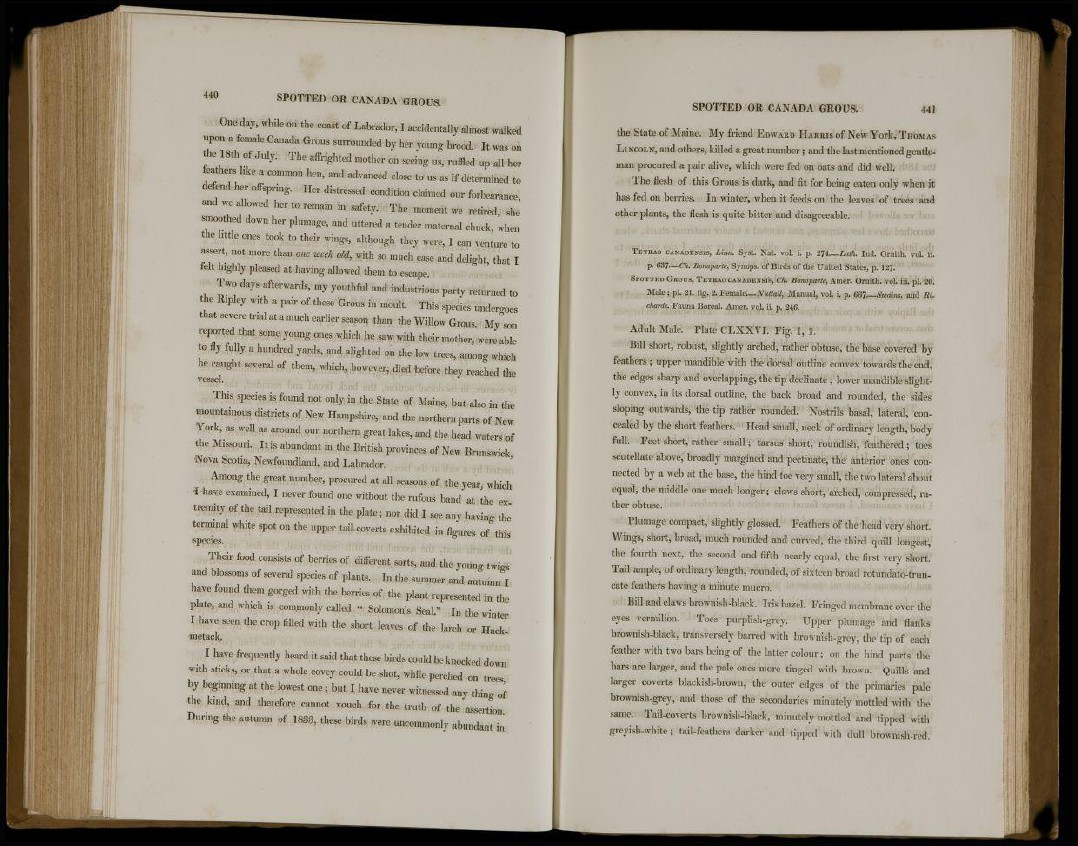
440
S P O T T E D OR C A N A D A GROUS.
One day, while on the coast of Labrador, I accidentally almost walked
upon a female Canada Grous surrounded by her young brood. It was on
the 18th of July. The affrighted mother on seeing us, ruffled up all her
feathers like a common hen, and advanced close to us as if determined to
defend her offspring. Her distressed condition claimed our forbearance,
and we allowed her to remain in safety. The moment we retired, she
smoothed down her plumage, and uttered a tender maternal chuck, when
the little ones took to their wings, although they were, I can venture to
assert, not more than one week old, with so much ease and delight, that I
felt highly pleased at having allowed them to escape.
Two days afterwards, my youthful and industrious party returned to
the Ripley with a pair of these Grous in moult. This species undergoes
that severe trial at a much earlier season than the Willow Grous. My son
reported that some young ones which he saw with their mother, were able
to fly fully a hundred yards, and alighted on the low trees, among which
he caught several of them, which, however, died before they reached the
vessel.
This species is found not only in the State of Maine, but also in the
mountainous districts of New Hampshire, and the northern parts of New
York, as well as around our northern great lakes, and the head waters of
the Missouri. It is abundant in the British provinces of New Brunswick,
•Nova Scotia, Newfoundland, and Labrador.
Among the great number, procured at all seasons of the year, which
I have examined, I never found one without the rufous band at the extremity
of the tail represented in the plate; nor did I see any having the
terminal white spot on the upper tail-coverts exhibited in figures of this
species.
Their food consists of berries of different sorts, and the young twigs
and blossoms of several species of plants. In the summer and autumn I
have found them gorged with the berries of the plant represented in the
plate, and which is commonly called " Solomon's Seal." In the winter
I have seen the crop filled with the short leaves of the larch or Hackmetack.
I have frequently heard it said that these birds could be knocked down
with sticks, or that a whole covey could be shot, while perched on trees,
by beginning at the lowest one; but I have never witnessed any thing of
the kind, and therefore cannot vouch for the truth of the assertion.
During the autumn of 1833, these birds were uncommonly abundant in
the State of Maine. My friend EDWARD H A R R I S of New York, THOMAS
LINCOLN, and others, killed a great number; and the last mentioned gentleman
procured a pair alive, which were fed on oats and did well.
The flesh of this Grous is dark, and fit for being eaten only when it
has fed on berries. In winter, when it feeds on the leaves of trees and
other plants, the flesh is quite bitter and disagreeable.
TETRAO CANADENSIS, Linn. Sysl. Nat. vol. i. p. 274.—Lath. Ind. Ornith. vol. ii.
p. 637—Ch. Bonaparte, Synops. of Birds of the United States, p. 127-
SPOTTED GROUS, TETRAO CANADENSIS, Ch. Bonaparte, Amer. Ornith. vol. iii. pi. 20.
Male; pL 21. fig. 2. Female—Nuttall, Manual, vol. i. p. C67—Swains, and Bi.
chords. Fauna Boreal. Amer. vol. ii. p. 24G.
Adult Male. Plate CLXXVI. Fig. 1, 1.
Bill short, robust, slightly arched, rather obtuse, the base covered by
feathers ; upper mandible with the dorsal outline convex towards the end,
the edges sharp and overlapping, the tip decimate ; lower mandible slightly
convex, in its dorsal outline, the back broad and rounded, the sides
sloping outwards, the tip rather rounded. Nostrils basal, lateral, concealed
by the short feathers. Head small, neck of ordinary length, body
full. Feet short, rather small; tarsus short, roundish, feathered ; toes
scutellate above, broadly margined and pectinate, the anterior ones connected
by a web at the base, the hind toe very small, the two lateral about
equal, the middle one much longer; claws short, arched, compressed, rather
obtuse.
Plumage compact, slightly glossed. Feathers of the head very short.
Wings, short, broad, much rounded and curved, the third quill longest,
the fourth next, the second and fifth nearly equal, the first very short.
Tail ample, of ordinary length, rounded, of sixteen broad rotundato-truncate
feathers having a minute mucro.
Bill and claws brownish-black. Iris hazel. Fringed membrane over the
eyes vermilion. Toes purplish-grey. Upper plumage and flanks
brownish-black, transversely barred with brownish-grey, the tip of each
feather with two bars being of the latter colour; on the hind parts the
bars are larger, and the pale ones more tinged with brown. Quills and
larger coverts blackish-brown, the outer edges of the primaries pale
brownish-grey, and those of the secondaries minutely mottled with the
same. Tail-coverts brownish-black, minutely mottled and tipped with
greyish-white; tail-feathers darker and tipped with dull brownish-red.